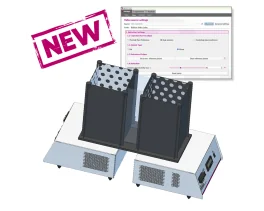Authors
E Ahmed, MK Tawfik, SS Essawy, AS Ahmed et al
Lab
Neuropharmacology Group, Institute of Neuroscience, Université Catholique de Louvain, Brussels, Belgium
Journal
Egyptian Journal of Basic and Clinical Pharmacology
Abstract
The hypothalamic-pituitary-adrenal (HPA) axis abnormalities have been linked to the occurrence of severe depressive and anxiety states. Venlafaxine, a serotonin and a noradrenaline reuptake inhibitor (SNRI), is an approved antidepressant agent with evidence of non-response to treatment in a subset of patients. In this study, 48 male mice (30-38 g) were used to evaluate the possible anxiolytic and antidepressant in_uence of intraperitoneal (i.p.) cysteamine (150 mg/kg/day) on i.p. venlafaxine (10mg/Kg and 20mg/Kg), as well as e_ects on brain-derived neurotrophic factor (BDNF) level and tropomyosin-related kinase B (TrkB) gene expression in prefrontal cortex (PFC) in corticosterone-induced anxiety/depression mouse model. The present results provided evidence on insu_cient venlafaxine anxiolytic and antidepressant e_ects in this model. However, cysteamine combined with venlafaxine caused signi_cant antidepressant behavioral e_ects together with a signi_cant increase in BDNF levels followed by TrkB receptor downregulation in mice PFC. In conclusion, we highlight the potential use of a combination therapy of venlafaxine and cysteamine as a therapeutic strategy for glucocorticoid-related symptoms of depression
BIOSEB Instruments Used
Forced Swimming Test: New FST DUAL SENSOR (BIO-FST-DSM)
Source :

 Pain - Thermal Allodynia / Hyperalgesia
Pain - Thermal Allodynia / Hyperalgesia Pain - Spontaneous Pain - Postural Deficit
Pain - Spontaneous Pain - Postural Deficit Pain - Mechanical Allodynia / Hyperalgesia
Pain - Mechanical Allodynia / Hyperalgesia Learning/Memory - Attention - Addiction
Learning/Memory - Attention - Addiction Physiology & Respiratory Research
Physiology & Respiratory Research











![Dynamic Weight Bearing 2.0 – Postural Module [Add-on]](https://bioseb.com/733-home_default/dynamic-weight-bearing-20-add-on-postural-module.jpg)
























 Pain
Pain Central Nervous System (CNS)
Central Nervous System (CNS) Neurodegeneration
Neurodegeneration Sensory system
Sensory system Motor control
Motor control Mood Disorders
Mood Disorders Other disorders
Other disorders Muscular system
Muscular system Joints
Joints Metabolism
Metabolism Cross-disciplinary subjects
Cross-disciplinary subjects CONFERENCES & MEETINGS
CONFERENCES & MEETINGS 